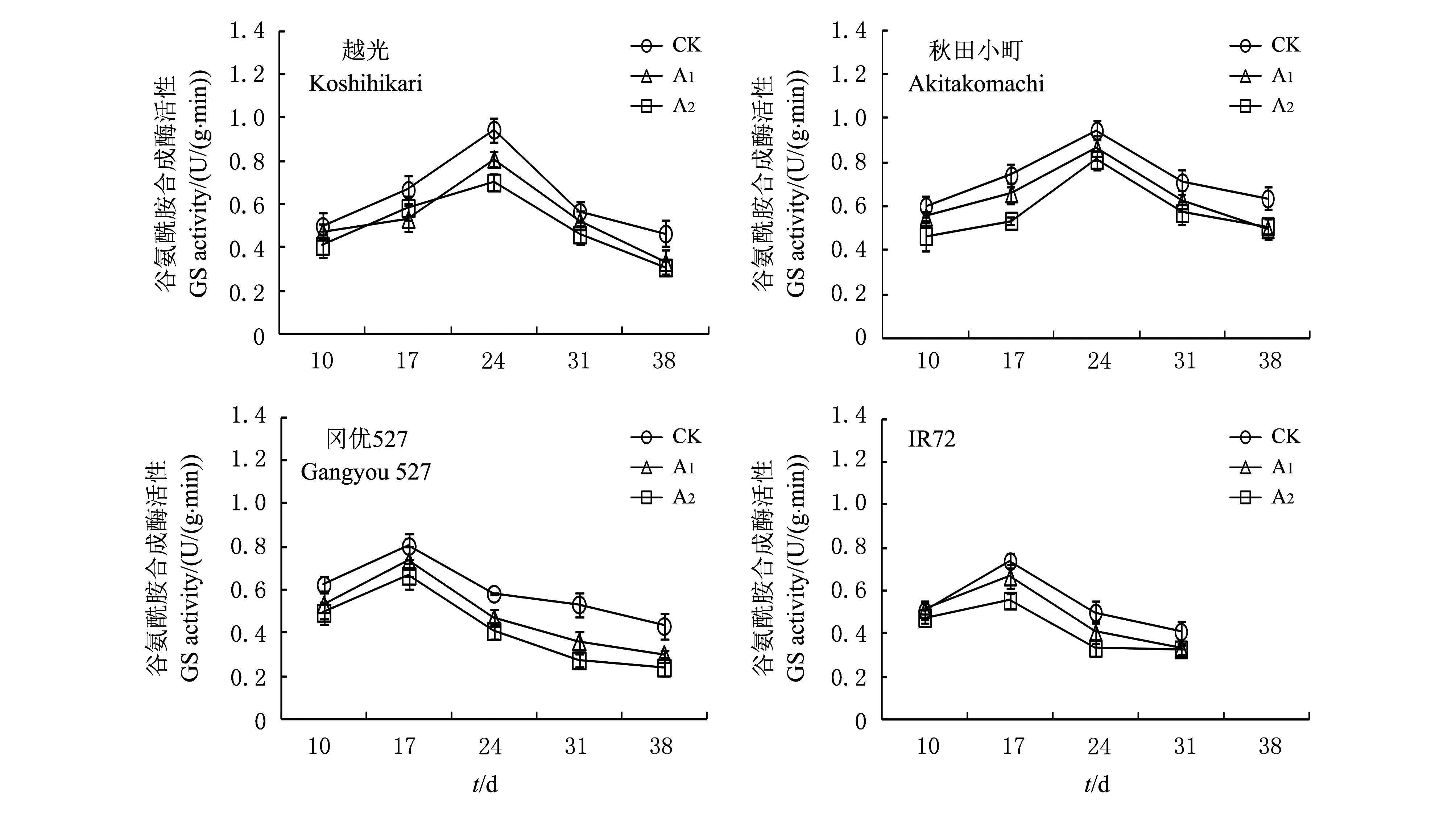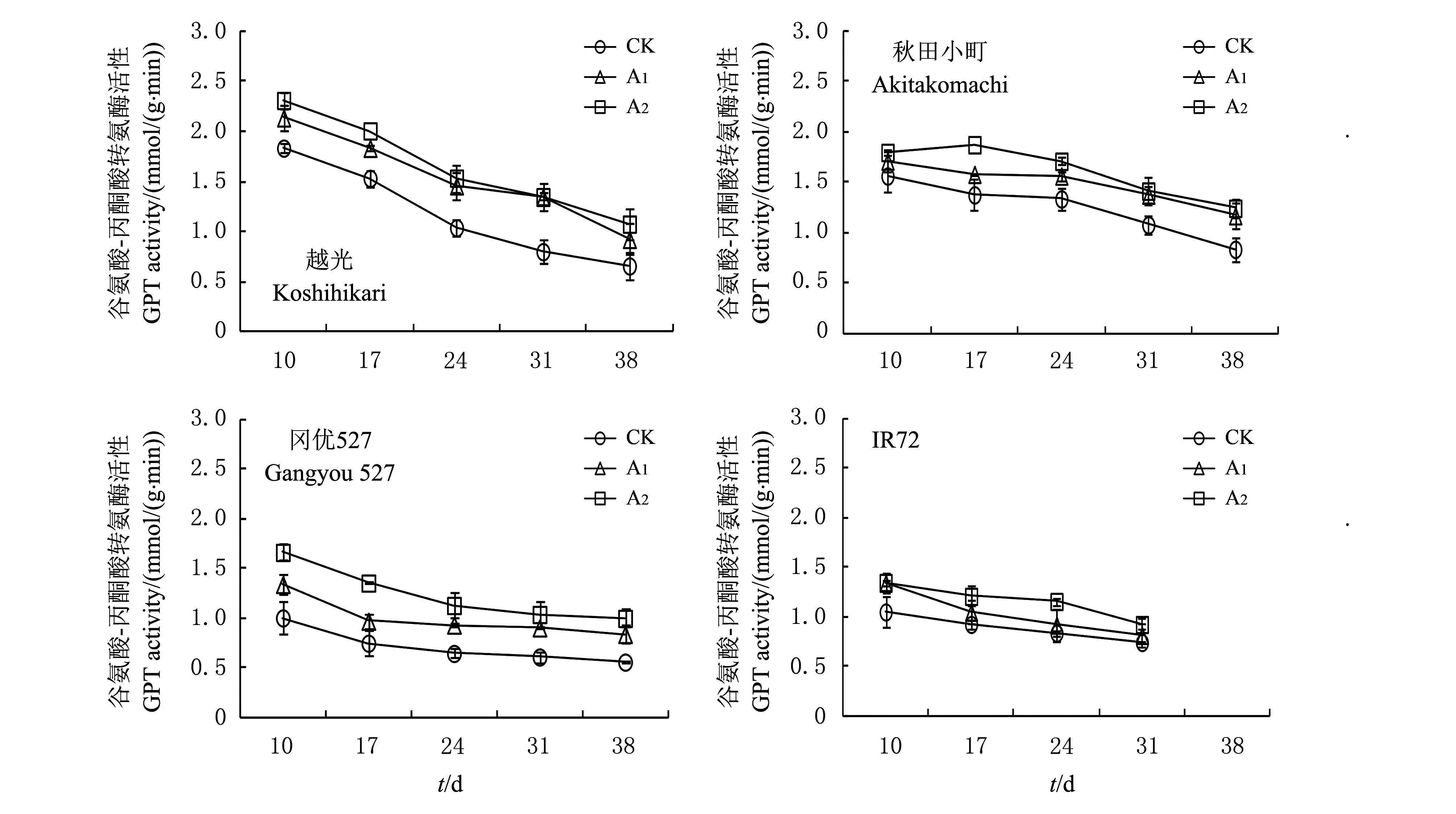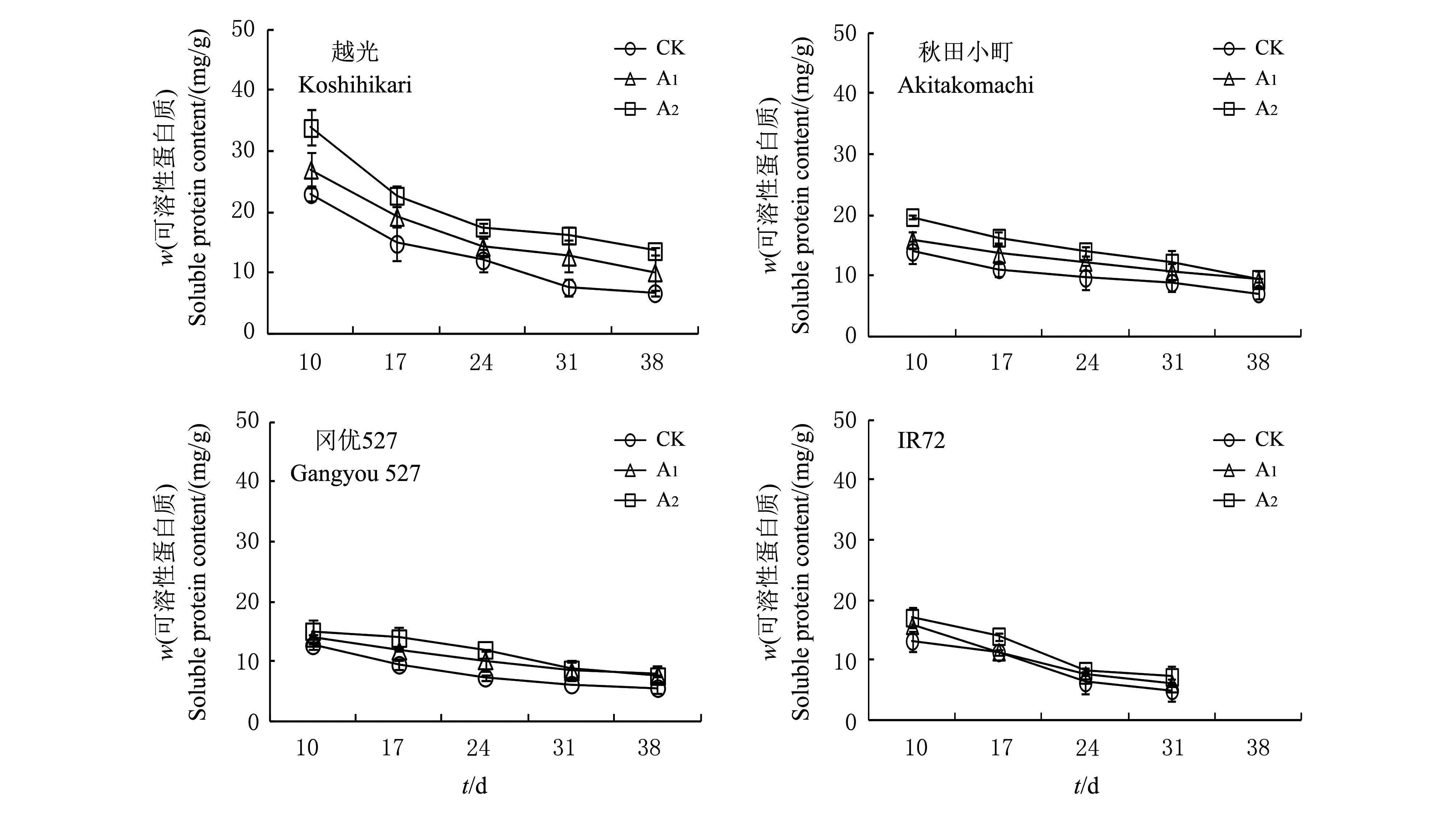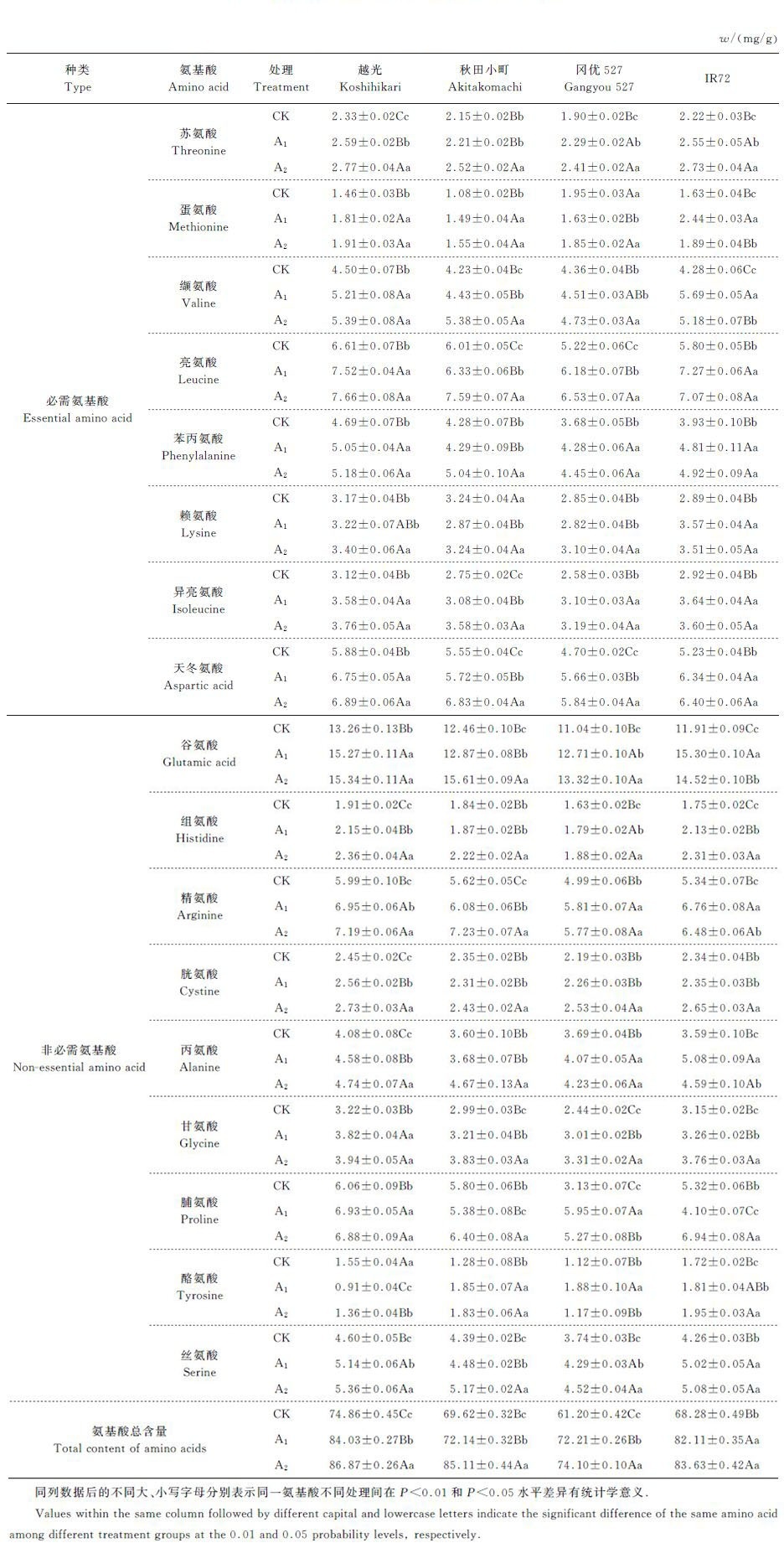| 灌浆结实期弱光对水稻籽粒氮代谢酶及蛋白质含量的影响 |
2.四川农业大学生命科学学院, 四川 雅安 625014
2. College of Life Science, Sichuan Agricultural University, Ya’an 625014, Sichuan, China
Based on previous studies, we carried out this experiment to evaluate the effect of low light on key enzyme activities of nitrogen metabolism and protein accumulation during the seed filling stage. The aims of this study were to study the dynamic changes of GS, GOT and GPT under different low light conditions during the seed filling stage, and evaluate the relationships between the activities of enzymes and protein accumulation.
The experiment was initiated at Sichuan Agricultural University, Ya’an, China, in 2013. Four cultivars including japonica cultivars Akitakomachi and Koshihikari, indica cultivar IR72, and hybrid indica cultivar Gangyou 527 were selected as the materials. All the cultivars were managed routinely till the flowering stage, then 25% shading (A1) and 50% shading (A2), were set respectively as the treatments till maturity by using shade net, and natural condition was set as CK. Each treatment plot was repeated 3 times and the rice panicles which grown uniformly were marked for further sample collection. After 10 days of treatments, the seed samples were collected per 7-day period till maturity and stored in freezer at -80 ℃. After harvest, the samples were used to measure GS, GOT and GPT activities, as well as soluble protein, total protein and amino acid contents.
Results showed that the GS activities were significantly decreased by 20.01%-30.52% at A2 than A1 (11.61%-19.36%) compared with CK, whereas, the activities of GOT and GPT increased significantly at A2 (GOT increased by 26.07%-36.82% and GPT increased by 26.07%-61.07%) than A1(GOT increased by 14.02%-23.02% GPT increased by 11.81%-33.83%) compared with CK. In consistent with GOT and GPT, patterns of soluble protein, total protein, as well as amino acids were also significantly increased under low light conditions especially at A2 (compared with CK, soluble protein increased by 31.19%-70.51%, total protein increased by 16.02%-28.89%, and amino acids increased by 16.04%-22.48% at A2). The correlation analysis showed that GS activity was negatively correlated to soluble protein, total protein and amino acids under low light conditions, however, GOT and GPT showed positive correlations with soluble protein, total protein and amino acids.
Based on the results, we speculated that the synthesis of protein of rice grain was more significantly affected by GOT and GPT which tended to increase the accumulation of both protein and amino acids, compared with GS. In addition, in consistent with previous studies, the low light conditions were beneficial for protein and amino acid synthesis of rice grain during the seed filling stage.
光照是影响植物生长发育的重要环境因子之一[1]。光照不足即弱光会导致作物碳固定减少,光合作用降低,叶片衰老加快,因而导致产量明显降低[2, 3, 4, 5, 6]。除了影响产量,弱光胁迫通过影响稻米的组分,也对稻米品质有着重要影响。蛋白质作为水稻的重要组分之一,其含量以及组成直接影响着稻米品质,如何提高稻米蛋白质含量兼顾营养品质一直受到研究者的重视[7]。关于弱光对稻米籽粒蛋白质的影响,前人已做了相关研究。例如刘奇华等[8]研究指出在插秧至幼穗分化期弱光不利于蛋白质的合成,而在抽穗至成熟期弱光则利于蛋白质的积累。任万军等[9]和MO等[10]同样研究发现灌浆期弱光可提高稻米蛋白质含量。蛋白质合成过程中,谷氨酰胺合酶(glutamine synthetase,GS)、谷氨酸-草酰乙酸转氨酶(glutamic oxalo-acetic transaminase,GOT)和谷氨酸-丙酮酸转氨酶(glutamate pyruvate transaminase,GPT)是涉及氮代谢的关键酶,其活性显著影响着蛋白质与氨基酸含量[11, 12, 13]。自然界中的无机氮主要通过谷氨酰胺合成酶/谷氨酸合成酶循环同化NH4+为谷氨酸和谷氨酰胺,该过程是整个氮代谢的中心环节,进而又通过GOT和GPT等转氨酶作用转化为其他必需或非必需氨基酸,为蛋白质合成提供前体物质。尽管前人关于弱光胁迫对稻米籽粒蛋白质的影响已经进行了大量研究,但关于弱光对氮代谢关键酶(GS,GOT,CPT)的影响还鲜有报道。鉴于此,本文探讨了水稻灌浆结实期不同程度弱光胁迫对籽粒氮代谢关键酶、可溶性蛋白质以及成熟时蛋白质与氨基酸组分的影响,以探讨影响稻米品质的机制。
1 材料与方法 1.1 试验材料供试水稻品种为粳稻越光和秋田小町,籼稻IR72,以及杂交籼稻冈优527等4个品种。
1.2 试验设计试验于2013年4—9月在四川农业大学教学农场进行,供试土壤为紫色土,基础肥力:有机质20.18 g/kg,全氮1.31 g/kg,速效氮110.95 mg/kg,速效磷26.52 mg/kg,速效钾143.43 mg/kg。试验地的肥料用量为尿素322.5 kg/hm2、过磷酸钙630 kg/hm2、氯化钾240 kg/hm2,分蘖期追施尿素,基追肥施用比例为7∶3,其余采用大田常规管理,确保栽培管理措施无差异。
试验采用对比实验方案,设置2个处理,分别为遮光25%(A1)和遮光50%(A2),以自然条件为对照(CK)。遮光处理为水稻开花后,在高约1.5 m铁架上挂上白色纱布为A1处理,挂黑色遮阴网为A2处理,每小区面积16 m2,重复3次。每小区选取生长基本一致的植株挂牌标记,自遮光后第10天起每7 d选取各穗强势籽粒取样1次,取样直至籽粒成熟。取样时间在上午8:00—9:00,样品用液氮速冻,并放入-80 ℃冰箱中保存,以待后期酶活测定。水稻成熟后另取样品置于80 ℃烘箱中烘干后脱糙、粉碎,并过100目筛,以进行蛋白质、氨基酸的测定。
1.3 测定项目与方法GS活性测定根据赵全志等[14]方法,取25粒水稻籽粒,加入缓冲液(pH 8.0)研磨并离心制成粗酶液。取0.7 mL粗酶液和0.7 mL ATP,并与1.6 mL反应混合液(Tris,MgSO4·7H2O、谷氨酸钠盐、半胱氨酸、EDTA、盐酸羟胺,pH 7.4)混合,于30 ℃下保温30 min,加入显色剂并离心,在540 nm测定吸光值。酶活性单位定义为30 ℃下30 min内平均每1 min反应液AODs等于0.01为1个酶活性单位。
GOT和GPT活性采用吴良欢等[15]的方法,籽粒加缓冲液(pH 7.2)研磨并离心制成粗酶液。取10 mL试管加入酶粗制剂0.1 mL 和GOT(或GPT)底物液0.5 mL,37 ℃下水浴30 min,加入2,4-二硝基苯肼液0.5 mL终止反应,37 ℃水浴20 min后加入0.4 mol/L NaOH 5 mL,在500 nm下比色。GOT或GPT活性以每1 g鲜样在30 min内平均每1 min反应生成的丙酮酸1 μmol表示。
可溶性蛋白质含量测定采用考马斯亮蓝法[16];蛋白质含量测定使用瑞典Buchi B-324全自动凯氏定氮仪测定;氨基酸含量测定使用日立L-8800氨基酸分析仪测定。
1.4 数据分析以上测定至少重复3次,使用SigmaPlot 12.5及Excel 2007制作图表,并使用SAS Enterprise Guide 4.3进行方差分析及显著性检验。
2 结果与分析 2.1 弱光对水稻灌浆结实期籽粒氮代谢关键酶活性的影响从图1可以看出,水稻灌浆期GS活性呈单峰曲线变化,总的表现为随灌浆进程逐渐上升,到达峰值后又逐渐下降,冈优527和IR72均比越光和秋田小町提前7 d到达峰值。方差分析可知,GS活性品种间表现差异显著,越光和秋田小町显著高于冈优527和IR72。弱光下GS活性显著降低,且影响程度随着弱光程度的增加而加深(A2>A1)。总体上,4个品种在A1和A2处理下GS活性分别比对照下降11.61%~19.36%和20.01%~30.52%,其中以冈优527下降幅度最大。

|
| 图1 灌浆结实期籽粒中谷氨酰胺合成酶活性的动态变化 Fig.1 Dynamic changes of GS activities of rice during the seed filling stage |
如图2所示,除秋田小町GOT活性在灌浆期先上升后下降外,其余3个品种GOT活性均随着灌浆进程而下降,下降程度依次为越光>IR72>冈优527。方差分析可知,弱光显著提高了4个品种的GOT活性,且弱光程度越深GOT活性越高(A2>A1)。4个品种在A1与A2处理下GOT活性分别比对照提高14.02%~23.02%和26.07%~36.82%。

|
| 图2 灌浆结实期籽粒中谷氨酸-草酰乙酸转氨酶活性的动态变化 Fig.2 Dynamic changes of GOT activities of rice during the seed filling stage |
GPT趋势总体在4个品种间表现较为一致(图3),除秋田小町A2处理外,其余均随着灌浆进程而下降,总体下降程度依次为越光>冈优527>秋田小町>IR72。与GOT表现相似,4个品种弱光处理均极显著提高了GPT活性,且随着弱光程度加深GPT提高更加明显(A2>A1)。总体上,4个品种A1和A2处理GPT活性分别比对照提高11.81%~33.83%和26.07%~61.07%,以冈优527影响程度最深。

|
| 图3 灌浆结实期籽粒中谷氨酸-丙酮酸转氨酶活性的动态变化 Fig.3 Dynamic changes of GPT activities of rice during the seed filling stage |
如图4所示,4个品种籽粒的可溶性蛋白质含量均随着灌浆进程呈下降趋势,下降程度依次为越光>IR72>秋田小町>冈优527。方差分析表明,弱光极显著地提高了籽粒中的可溶性蛋白质含量,且弱光程度越重其含量越高。在A1和A2处理下可溶性蛋白质平均含量分别比对照提高12.06%~36.77%和31.19%~70.51%,其中以越光增加程度最大,其次是冈优527。

|
| 图4 灌浆结实期籽粒中可溶性蛋白质含量的动态变化 Fig.4 Dynamic changes of the soluble protein content of rice during the seed filling stage |
图5可知,弱光有利于蛋白质的合成。其中A1处理显著提高了蛋白质含量,而A2处理极显著提高了蛋白质含量。在A1和A2处理下,蛋白质分别比对照提高6.43%~13.38%和16.02%~28.89%。籼稻IR72和冈优527增幅高于粳稻越光和秋田小町。

|
| 图上不同大写字母表示在P<0.01水平差异有高度统计学意义. Different capital letters above the bar indicate statistically highly significant differences at the 0.01 probability level. 图5 弱光处理对水稻成熟籽粒蛋白质含量的影响 Fig.5 Effect of low light on protein content of rice grain |
同弱光对蛋白质影响的表现基本一致,弱光处理总体上显著提高了氨基酸含量(表1),且提高程度A2>A1。但值得一提的是冈优527在弱光处理下的蛋氨酸含量低于对照(A1低16.41%,A2低5.13%),秋田小町和冈优527赖氨酸在A1处理下均低于对照,其余品种在弱光处理下氨基酸各组分含量均高于对照。总体而言,必需氨基酸含量在A1和A2处理下分别比对照高3.86%~11.86%和16.37%~22.15%,非必需氨基酸分别高3.47%~22.96%和15.72%~23.64%。综合起来,在A1和A2处理下氨基酸总含量比对照分别提高3.62%~20.25%和16.04%~22.48%。
| 表1 弱光处理对水稻成熟籽粒氨基酸组分含量的影响Table 1 Effect of low light on amino acid contents of rice grain at maturity |
 |
| 点击放大 |
在水稻中,氮元素主要是通过GS/GOGAT(谷氨酰胺合成酶/谷氨酸合成酶)途径同化为谷氨酰胺或谷氨酸,进而转化为其他氨基酸[17, 18]。作为典型的喜铵植物,GS在水稻氮素营养过程中乃至产量、品质的形成过程中起着关键性的作用[11]。金正勋等[11]研究指出,在灌浆前期籽粒中GS活性与水稻食味值、最高黏度、崩解值呈负相关,而在灌浆后期呈正相关;同时,还发现GS在灌浆前期与蛋白质呈正相关,灌浆中后期则呈负相关,据此分析GS可能主要通过影响蛋白质的合成而间接影响水稻的蒸煮食味品质。而黄星等[19]研究指出GS与蛋白质相关性不显著,而与可溶性蛋白质含量呈显著负相关。曹珍珍等[20]则指出GS与可溶性蛋白质含量呈极显著正相关。在本实验中,GS活性在籽粒中随弱光程度加深而下降明显,而可溶性蛋白质、蛋白质和氨基酸含量却随着弱光加深而显著上升,GS与可溶性蛋白质、蛋白质和氨基酸均呈显著负相关。OBENDORF等[21]研究指出,谷氨酰胺主要是在叶片中生成,然后转运到籽粒中,再在籽粒中转化为其他氨基酸[22, 23]。这表明,氨同化过程可能主要发生在叶片中,籽粒中GS活性变化对蛋白质合成影响较小[12, 24],这可能与水稻籽粒在弱光胁迫下的防御代谢有关,但还有待于进一步研究[19, 20]。除了氨同化过程,转氨基作用同样是植物体内氮代谢的重要环节。在水稻籽粒发育过程中,GOT可以促进L-谷氨酸与草酰乙酸合成L-天冬氨酸,进而合成限制性必需氨基酸;GPT则是负责催化谷氨酸和丙酮酸之间的转氨作用促进生成新的酮酸和α-氨基酸;水稻籽粒通过GOT和GPT的转氨作用最终促进蛋白质的合成[25]。前人研究表明GOT和GPT活性上升显著提高了蛋白质含量[12, 26]。同样,在本实验中,GOT和GPT活性均随着弱光加深而显著提高,相关分析表明,GOT和GPT均与蛋白质含量呈极显著正相关。这表明,相对于GS,GOT和GPT可能显著影响着水稻籽粒中蛋白质合成。
前人多数研究已表明灌浆结实期弱光有利于蛋白质的积累[8, 10, 27],这也可以从弱光下碳水化合物的减少可见。任万军等[9]研究指出,弱光下稻株全氮含量会增加并促进氮素向籽粒转移,因而促进蛋白质的合成。本研究同样发现弱光下籽粒中蛋白质含量均显著增加,且随着弱光程度的加深而增强(A2>A1),这也同董明辉等[28]的研究结果是一致的。除了蛋白质含量,籽粒可溶性蛋白质含量也显著增加,且A2>A1。可溶性蛋白质主要在同化物代谢过程中起着重要的作用,能提高细胞可溶性物质含量,从而增强细胞抗逆境能力[29]。
稻米营养价值的高低,不仅取决于蛋白质含量,还受其他品质成分的影响,尤其是必需氨基酸含量[7]。在本研究中,弱光显著增加了籽粒的氨基酸含量,其中必需氨基酸和非必需氨基酸含量增幅较为一致,均是A2>A1,这同周广洽等[30]的研究结论是一致的。氨基酸含量的提高主要由于GOT和GPT等酶活性的增强,由相关性分析可知,GOT和GPT活性也同氨基酸含量呈极显著正相关。在必需氨基酸中,赖氨酸被认为是稻米蛋白质合成的第一限制性氨基酸,苏氨酸和蛋氨酸则分别是第二、三限制性氨基酸[31, 32]。在本研究中,3个氨基酸组分在品种间表现有所差异,其中赖氨酸含量在秋田小町和冈优527 A1处理下甚至低于对照,其余品种在弱光处理下增幅也不高;4个品种的苏氨酸含量在弱光处理下均显著增加;蛋氨酸含量除冈优527弱光下降低外,其余均显著提高。这表明氨基酸组分除受环境因子影响外,品种间差异也不可忽视[33]。
综上所述,灌浆结实期在弱光处理下,水稻籽粒中GS活性显著降低,而GPT、GOT、可溶性蛋白质、蛋白质以及氨基酸含量均明显增加,且影响程度随着弱光的加深而加重。说明在未来关于稻米蛋白质研究过程中,应更加注重GOT和GPT的活性。值得一提的是,虽然弱光下稻米的蛋白质含量升高,但过高的蛋白质同样会导致米饭的蒸煮食味品质下降,因此,未来研究在注意提高稻米营养品质的同时,应同时兼顾营养品质与食味品质的均衡。
| [1] | 杜彦修,季新,张静,等.弱光对水稻生长发育影响研究进展.中国生态农业学报,2013,21(11):1307-1317.DU Y X, JI X, ZHANG J, et al. Research progress on the impacts of low light intensity on rice growth and development. Chinese Journal of Eco-Agriculture, 2013,21(11):1307-1317.(in Chinese with English abstract) |
| [2] | LV F, LIU J, MA Y, et al. Effect of shading on cotton yield and quality on different fruiting branches. Crop Science, 2013,53(6):2670-2678. |
| [3] | CHEN E, WANG Z, YIN Y, et al. Shading after anthesis in wheat influences the amount and relative composition of grain proteins. Journal of Agricultural Science, 2013,151(1):44-55. |
| [4] | BROUWER B, ZIOLKOWSKA A, BAGARD M, et al. The impact of light intensity on shade-induced leaf senescence. Plant, Cell & Environment, 2012,35(6):1084-1098. |
| [5] | 周卫霞,董朋飞,王秀萍,等.弱光胁迫对不同基因型玉米籽粒发育和碳氮代谢的影响.作物学报,2013,39(10):1826-1834. ZHOU W X, DONG P F, WANG X P, et al. Effects of low-light stress on kernel setting and metabolism of carbon and nitrogen in different maize (Zea mays L.) genotypes. Acta Agronomica Sinica, 2013,39(10):1826-1834. (in Chinese with English abstract) |
| [6] | 潘圣刚,闻祥成,莫钊文,等.施氮量和遮荫对不同基因型水稻产量及一些生理特性的影响.中国水稻科学,2015,29(2):141-149. PAN S G, WEN X C, MO Z W, et al. Effects of nitrogen application and shading on yields and some physiological characteristics in different rice genotypes.Chinese Journal of Rice Science, 2015,29(2):141-149. (in Chinese with English abstract) |
| [7] | 王康君,葛立立,范苗苗,等.稻米蛋白质含量及其影响因素的研究进展.作物杂志,2011(6):1-6. WANG K J, GE L L, FAN M M, et al. Research progress on protein content and its influencing factors in rice.Crops, 2011(6):1-6. (in Chinese with English abstract) |
| [8] | 刘奇华,李天,蔡建,等.不同生育期遮光对水稻籽粒直链淀粉及蛋白质含量的影响.中国农学通报,2006,22(8):234-237. LIU Q H, LI T, CAI J, et al. Effects of shading at different growth stages on amylose and protein contents in rice grain.Chinese Agricultural Science Bulletin, 2006,22(8):234-237. (in Chinese with English abstract) |
| [9] | 任万军,杨文钰,徐精文,等.弱光对水稻籽粒生长及品质的影响.作物学报,2003,29(5):785-790. REN W J, YANG W Y, XU J W, et al. Effect of low light on grains growth and quality in rice.Acta Agronomica Sinica, 2003,29(5):785-790. (in Chinese with English abstract) |
| [10] | MO Z, LI W, PAN S, et al. Shading during the grain filling period increases 2-acetyl-1-pyrroline content in fragrant rice. Rice, 2015,8(1):9. |
| [11] | 金正勋,钱春荣,杨静,等.水稻灌浆成熟期籽粒谷氨酰胺合成酶活性变化及其与稻米品质关系的初步研究.中国水稻科学,2007,21(1):103-106. JIN Z X, QIAN C R, YANG J, et al. Changes of activity of glutamine synthetase during grain filling and its influence on rice grain quality.Chinese Journal of Rice Science, 2007,21(1):103-106. (in Chinese with English abstract) |
| [12] | 梁成刚,陈利平,汪燕,等.高温对水稻灌浆期籽粒氮代谢关键酶活性及蛋白质含量的影响.中国水稻科学,2010,24(4):398-402. LIANG C G, CHEN L P, WANG Y, et al. Effects of high temperature on key enzyme activities of nitrogen metabolism and protein content during rice grain filling.Chinese Journal of Rice Science, 2010,24(4):398-402. (in Chinese with English abstract) |
| [13] | 孙永健,孙园园,李旭毅,等.水氮互作下水稻氮代谢关键酶活性与氮素利用的关系.作物学报,2009,35(11):2055-2063. SUN Y J, SUN Y Y, LI X Y, et al. Relationship of activities of key enzymes involved in nitrogen metabolism with nitrogen utilization in rice under water-nitrogen interaction.Acta Agronomica Sinica, 2009,35(11):2055-2063. (in Chinese with English abstract) |
| [14] | 赵全志,陈静蕊,刘辉,等.水稻氮素同化关键酶活性与叶色变化的关系.中国农业科学,2008,41(9):2607-2616. ZHAO Q Z, CHEN J R, LIU H, et al. Relationship between activities of nitrogen assimilation enzymes and leaf color of rice.Scientia Agricultrua Sinica, 2008,41(9):2607-2616. (in Chinese with English abstract) |
| [15] | 吴良欢,蒋式洪,陶勤南,等.植物转氨酶(GOT和GPT)活度比色测定方法及其应用.土壤通报,1998,29(3):136-138. WU L H, JIANG S H, TAO Q N, et al. The measurement method of GOT and GPT.Chinese Journal of Soil Science, 1998,29(3):136-138. (in Chinese) |
| [16] | 熊庆娥,叶珍,杨世明,等.植物生理学实验教程.成都:四川科学技术出版社,2003:83-84. XIONG Q E, YE Z, YANG S M, et al. Plant Physiology Experimental Tutorial. Chengdu: Sichuan Science and Technology Press, 2003:83-84. (in Chinese) |
| [17] | MARTIN A, LEE J, KICHEY T, et al. Two cytosolic glutamine synthetase isoforms of maize are specifically involved in the control of grain production. Plant Cell, 2006,18(11):3252-3274. |
| [18] | HIREL B, BERTIN P, QUILLERE I, et al. Towards a better understanding of the genetic and physiological basis for nitrogen use efficiency in maize. Plant Physiology, 2001,125:1258-1270. |
| [19] | 黄星,李晓光,刘洪亮,等.水稻籽粒蛋白质含量选择对杂交后代蛋白质含量及氮代谢关键酶活性的影响.中国水稻科学,2009,23(6):657-660. HUANG X, LI X G, LIU H L, et al. Effects of grain protein content selection on protein content and key enzymes activities for nitrogen metabolism in rice hybrid progenies.Chinese Journal of Rice Science, 2009,23(6):657-660. (in Chinese with English abstract) |
| [20] | 曹珍珍,张其芳,韦克苏,等.水稻籽粒氮代谢几个关键酶对花后高温胁迫的响应及其与贮藏蛋白积累关系.作物学报,2012,38(1):99-106. CAO Z Z, ZHANG Q F, WEI K S, et al. Response of some key enzyme activities involved in nitrogen metabolism to high temperature at filling stage and its relation to storage protein accumulation in rice grain.Acta Agronomica Sinica, 2012,38(1):99-106. (in Chinese with English abstract) |
| [21] | OBENDORF R L, WETTLAUFER S H. Precocious germination during in vitro growth of soybean seeds. Plant Physiology, 1984,76:1023-1028. |
| [22] | RAINBIRD R M, THRONE J H, HARDY R W F. Role of amides, amino acids, and ureides in the nutrition of developing soybean seeds. Plant Physiology, 1984,74:329-334. |
| [23] | VERNOOY C D, THRONE J H, LIN W, et al. Cessation of assimilate uptake in maturing soybean seeds. Plant Physiology, 1986,82:222-225. |
| [24] | XIE Z J, JIANG D, CAO W X, et al. Effects of post anthesis soil water status on the key regulatory enzymes of starch and protein accumulation in wheat grains. Journal of Plant Molecular Biology, 2003,29(4):309-316. |
| [25] | 彭辉辉,刘强,荣湘民,等.不同栽培法对水稻谷草转氨酶与天冬氨酸激酶活性的影响.湖南农业大学学报(自然科学版),2005,31(3):233-237. PENG H H, LIU Q, RONG X M, et al. Effects of different cultural methods on activities of GOT and AK of rice.Journal of Hunan Agricultural University (Natural Science), 2005,31(3):233-237. (in Chinese with English abstract) |
| [26] | ZHU D Q, ZHU X L, WANG Y, et al. Several physiological parameters in relation to grain protein content in winter wheat (Triticum aestivum). Acta Agronmica Sinica. 1991,17(2):135-144. |
| [27] | 刘奇华,蔡建,李天,等.水稻籽粒灌浆特性及品质对孕穗期弱光胁迫的响应.江西农业大学学报,2007,29(2):172-175. LIU Q H, CAI J, LI T, et al. Response of grain-filling properties and quality in rice to weak light during initial period of young spike.Acta Agriculturae Universitatis Jiangxiensis, 2007,29(2):172-175. (in Chinese with English abstract) |
| [28] | 董明辉,惠锋,顾俊荣,等.灌浆期不同光强对水稻不同粒位籽粒品质的影响.中国生态农业学报,2013,21(2):164-170. DONG M H, HUI F, GU J R, et al. Effect of light intensity on grain quality of rice at different spike positions during grain-filling stage.Chinese Journal of Eco-Agriculture, 2013,21(2):164-170. (in Chinese with English abstract) |
| [29] | 颉建明,郁继华,颉敏华,等.低温弱光下辣椒3种渗透调节物质含量变化及其与品种耐性的关系.西北植物学报,2009,29(1):105-110. XIE J M, YU J H, XIE M H, et al. Changes of three osmotic regulatory metabolites in leaves of pepper under low temperature and poor light stress and relations between its and varietal tolerance.Acta Botanica Boreali-Occidentalia Sinica, 2009,29(1):105-110. (in Chinese with English abstract) |
| [30] | 周广洽,徐孟亮,谭周兹,等.温光对稻米蛋白质及氨基酸含量的影响.生态学报,1997,17(5):537-542. ZHOU G Q, XU M L, TAN Z Z, et al. Effects of ecological factors of protein and amino acids of rice.Acta Ecologica Sinica, 1997,17(5):537-542. (in Chinese with English abstract) |
| [31] | YOON M R, LEE S C, KANG M Y, et al. The lipid composition of rice cultivars with different eating qualities. Journal of Korean Society Applied Biological Chemistry, 2012,55(2):291-295. |
| [32] | 焦爱霞,杨昌仁,曹桂兰,等.水稻蛋白质含量的遗传研究进展.中国农业科学,2008,41(1):1-8. JIAO A X, YANG C R, CAO G L, et al. Progress in genetic research on protein content of rice.Scientia Agricultura Sinica, 2008,41(1):1-8. (in Chinese with English abstract) |
| [33] | 谢桂先,刘强,荣湘民,等.稻米氨基酸含量的影响因素及其研究进展.湖南农业科学,2008(1):32-34. XIE G X, LIU Q, RONG X M, et al. Advances in influencing factors of the amino acid contents of rice.Hunan Agricultural Sciences, 2008(1):32-34. (in Chinese with English abstract) |
 2016, Vol. 42
2016, Vol. 42


